- News
- Reviews
- Bikes
- Components
- Bar tape & grips
- Bottom brackets
- Brake & gear cables
- Brake & STI levers
- Brake pads & spares
- Brakes
- Cassettes & freewheels
- Chains
- Chainsets & chainrings
- Derailleurs - front
- Derailleurs - rear
- Forks
- Gear levers & shifters
- Groupsets
- Handlebars & extensions
- Headsets
- Hubs
- Inner tubes
- Pedals
- Quick releases & skewers
- Saddles
- Seatposts
- Stems
- Wheels
- Tyres
- Tubeless valves
- Accessories
- Accessories - misc
- Computer mounts
- Bags
- Bar ends
- Bike bags & cases
- Bottle cages
- Bottles
- Cameras
- Car racks
- Child seats
- Computers
- Glasses
- GPS units
- Helmets
- Lights - front
- Lights - rear
- Lights - sets
- Locks
- Mirrors
- Mudguards
- Racks
- Pumps & CO2 inflators
- Puncture kits
- Reflectives
- Smart watches
- Stands and racks
- Trailers
- Clothing
- Health, fitness and nutrition
- Tools and workshop
- Miscellaneous
- Buyers Guides
- Features
- Forum
- Recommends
- Podcast
review
£2,699.00
VERDICT:
Brilliant handling bike with superb performance and reliable build kit, let down by fiddly seatclamp
Weight:
7,690g
Contact:
At road.cc every product is thoroughly tested for as long as it takes to get a proper insight into how well it works. Our reviewers are experienced cyclists that we trust to be objective. While we strive to ensure that opinions expressed are backed up by facts, reviews are by their nature an informed opinion, not a definitive verdict. We don't intentionally try to break anything (except locks) but we do try to look for weak points in any design. The overall score is not just an average of the other scores: it reflects both a product's function and value – with value determined by how a product compares with items of similar spec, quality, and price.
What the road.cc scores meanGood scores are more common than bad, because fortunately good products are more common than bad.
- Exceptional
- Excellent
- Very Good
- Good
- Quite good
- Average
- Not so good
- Poor
- Bad
- Appalling
The Eddy Merckx SanRemo76 follows the form of the EMX-525 launched on the eve of the 2012 Tour de France. That bike heralded a new direction for the brand, one that focused on ride and handling and not chasing the title of the lightest frame, a battle that is concerning more than a handful of manufacturers. It also had the input of Eddy Merckx himself, and it was upon his insistence that handling and performance were key goals with the bike.

I rode the EMX-525 following the launch and can attest to the fine handling, and it's delightful to discover that the newly launched SanRemo76 displays similar characteristics. It doesn't take more than a few miles to feel quite happy on the new bike, and there is sense some of the EMX-525 has found its way into the SanRemo76. That's a very good thing.
Handling: Sheer brilliance
You learn a lot about a bike in the corners and the SanRemo76 is without doubt one of the nicest cornering bikes I've ridden in a while. Sure, all bikes will go round corners, but some display a bit more control, stability, and feedback, all factors that if in the right balance can give you the confidence to go that little bit faster. And who doesn't enjoy a spot of fast cornering? I know I do. You can sling this bike through any sort of corner at any speed, and it feels so well balanced and secure, that you can't help but grin every time. And go back for more. And more.
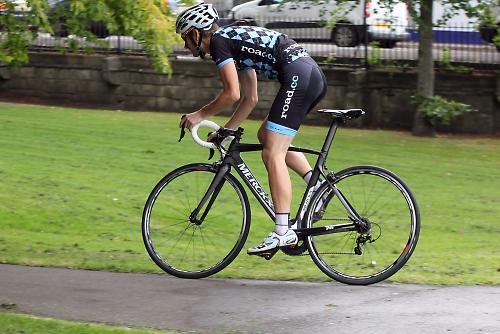
The SanRemo76 impresses everywhere else too. Everywhere that matters, like on the flat, down the hills even, rolling roads, even up the hills even though it isn't the lightest at a shade over 7.6kg. Perhaps the most appealing trait of this bike is the handling is really accessible. It's an easy bike to extract performance from, providing excellent form at any speed. It's equally happy at low speeds as it is at eye-watering, hold your breath speeds.
I was eager to find out how the SanRemo76 would perform with a number pinned to my jersey, so I duly swapped my regular Cannondale SuperSix Evo race bike and used the Merckx for the last race of my season. It proved to be a fine choice. It didn't help me to win the race (my lack of form is to blame there) but the SanRemo76 was a fast, comfortable, precise race bike that was docile in the high-speed bunch, but happy with the all-out efforts required to get in the breaks. I didn't feel at any disadvantage compared to my regular race bike, and I consider the Evo a benchmark.
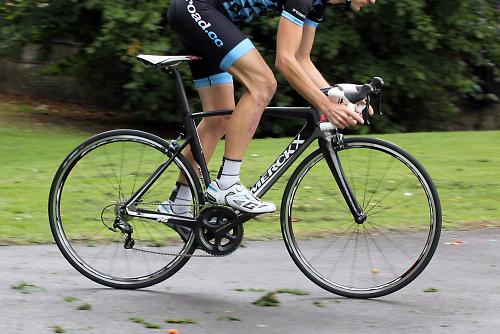
It's a highly capable race bike then, but it's no one-trick pony. If you're seeking a high performance, high-speed road bike not for racing but just for blasting around the lanes of a weekend, maybe a sportive, maybe for riding with your club, the SanRemo76 is a great long distance bike. It's impressively comfortable for a bike displaying so much stiffness when you push hard on the pedals, despite the aero seatpost surely not providing as much deflection as a conventional round post. I knocked out four- and six-hour rides quite happily.
Build: Solid and dependable Ultegra with sturdy Fulcrum wheels
The SanRemo76 range extends to three bikes: this £2,699 Shimano Ultegra 11-speed mechanical build; a Ultegra Di2 model at £3,349; and a 105 model costing £2,249.

Shimano's Ultegra 11-speed mechanical groupset probably offers the best cost-to-performance ratio of any of the manufacturers' current groupsets. It's probably the best groupset they've ever made, and there have been some bloody good groupsets from Shimano over the years.
The shift action is deliciously light and full of feedback, the brakes are authoritative with plenty of modulation and just enough bite, and the new 52/36 semi-compact chainset is quickly becoming my favourite choice for all riding. It's good for racing, but gives you a bit more scope on the hills when you're not racing, something I appreciate on some of the steeper local climbs.
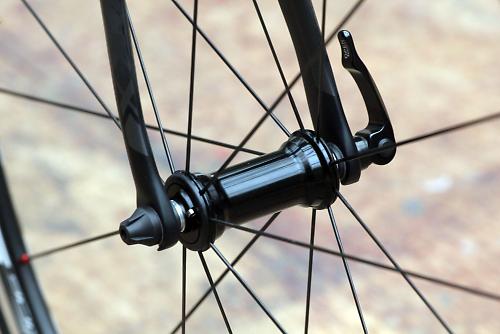
Fulcrum's Racing 5 wheels clearly help Merckx to keep the price down, and while they are a bit on the heavy side they're capable wheels with good stiffness and, if previous testing is anything to go by, excellent reliability.
The tyres are perhaps the only blemish on the overall build, and while there's nothing particularly wrong with the Vittoria Rubino Pro clincher tyres, they're not the lightest or most supple feeling tyres. Ride them till they wear out, then invest in some posher rubber is my advice.
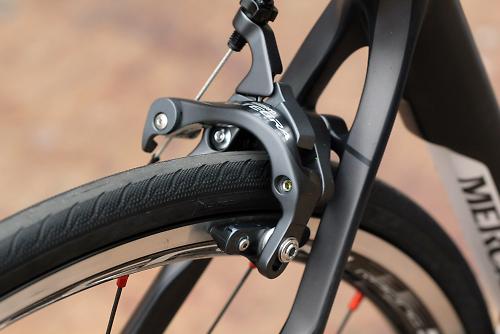
The Lizard Skin bar tape is worth a mention. It's just lovely. I'd be happy if every test bike came fitted with the stuff. It's nicely cushioned, not too much though, and its grippy feel works great with or without gloves, providing good adhesion even when you're sweating buckets.
The contact points consist of a Prologo Zero saddle that is more comfortable than its svelte looks might suggest, and a Deda Zero100 handlebar which provides a very nice shape, a little deeper than some compact bars but not too much, and a nice curve when riding right in the drops. A matching 11cm stem clamps it to the steerer tube, around which there were generous spacers on this test bike for adjusting the front-end height.
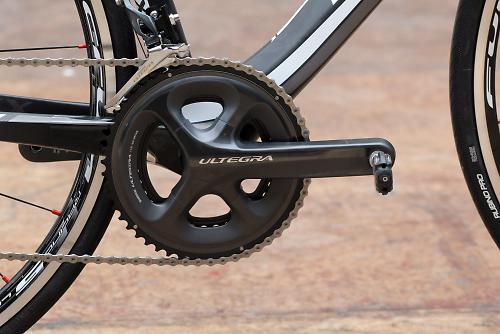
It's a purposeful build: nothing flash. For the budding racer this is the perfect setup: there are no expensive parts (relatively speaking) to wear out or suffer damage in a crash, and the price is reasonably competitive with other choices on the market. There are better specced bikes for the money, but the handling and performance of the Merckx has to be factored in, because it's definitely a cut above the average.
Frame
It's a decent looking frame, a fine collection of angular lines flowing into nice curves and the paint job works well to both highlight key panels and play down its bulk in other areas. The frame is all brought together by a pair of hugely oversized chainstays and massive bottom bracket area, which provides that essential stiffness.
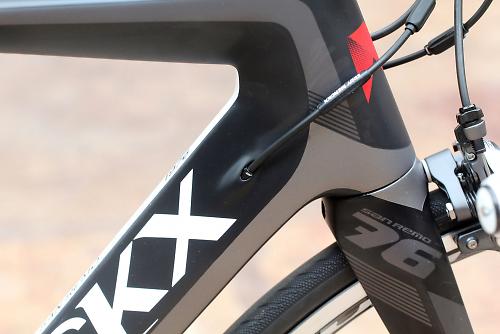
The frame has a hint of aerodynamics about it, but Merckx don't call it an aero bike and they certainly don't make any aero claims for it. It just happens to have aero shaped tube profiles, the curve of the down tube and the slender fork blades and that aero seat tube suggesting a bike capable of slicing through the air. All cables are internally routed as well which helps maintain some smooth airflow over the frame surfaces.
Eddy Merckx's many victories in the race this bike has been named after are listed on the spine of the down tube. (That's Milan-San Remo, and he won it seven times, first in 1966 and the last in 1976.) It's a nice touch, discrete enough to be reserved, but when friends get up close they notice and a discussion about Merckx invariably ensues. Which is nice. The bike is a conversation starter.
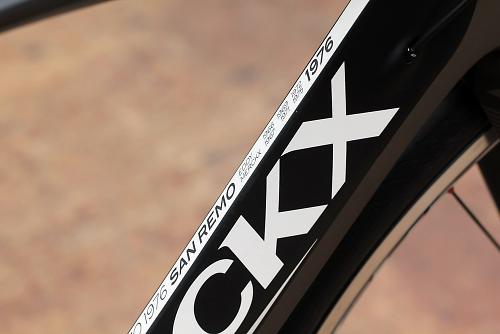
The fork has a kink at midway point and it's mirrored by the slim, kinked seat stays. The seat tube is an aero shaped affair and accommodates an aero seat post. That's all fine, but one serious problem with the Merckx comes when you want to adjust the seatpost height.
The seatpost is held in place by a novel mechanism with two Allen bolts on the back of the seatpost. Together they act to press an internal plate against the post. It's a system that works well, the seatpost didn't slip once during the test.

But accessing the two bolts is very fiddly. While the top bolt can be reached easily enough, I had to remove the rear wheel to get at the lower bolt. That makes measuring the saddle height from the bottom bracket tricky if you don't have a workstand. It means you can't easily make roadside adjustments to the saddle height, which if you're a fussy bugger with your saddle height like I am, will grind. I'm sure Merckx could have found a more user-friendly design.
Is it a deal breaker? Once it's set up it's not a problem, and once you've got your seat post height right setting it up after travelling shouldn't be a problem. If you're constantly adjusting your saddle height, as the great Eddy Merckx himself famously liked to do even during the races, then it might be enough to put you off.

There are the typical details that are now commonplace on top-end carbon race frames. So there's a 1 1/8in-1 1/2in tapered head tube and a BB86 press-fit bottom bracket, internal cable routing and Di2 compatibility. Six frame sizes are offered from 47 to 61cm.
Merckx claim a frame weight of 1,122g. That's high when compared to the competition. The whole bike as pictured weighs 7.6kg. But weight wasn't the main criteria for the company when designing this frame, as they said when they developed the EMX-525 which has inspired this new model.
Verdict
Brilliant handling bike with superb performance and reliable build kit, let down by fiddly seatclamp
road.cc test report
Make and model: Eddy Merckx San Remo 76
Size tested: 56
About the bike
State the frame and fork material and method of construction. List the components used to build up the bike.
As the name indicates, the SanRemo76 is meant as a tribute to Merckx's unbroken record of 7 victories in la Primavera. This high-performance race bike is designed and built for racers who focus on speed. Its longer top tube and lower head tube ensure a leaning forward aerodynamic position. Combined with the compact seatstays and oversized BB this accommodates a more aggressive riding style.
Tell us what the bike is for, and who it's aimed at. What do the manufacturers say about it? How does that compare to your own feelings about the bike?
The SanRemo76 road bike is billed as a high performance road bike 'ideal for cyclists who love to ride fast and want to compare themselves against other riders,' says Merckx. Sounds like it's the bike for the Strava generation. It's based on the EMX-525 but uses lower grade carbon fibre to make it more affordable.
Frame and fork
Overall rating for frame and fork
9/10
Tell us about the geometry of the frame and fork?
Ideal for performance-minded types and racing, with a long top tube and short head tube.
How was the bike in terms of height and reach? How did it compare to other bikes of the same stated size?
Just about perfect really.
Riding the bike
Was the bike comfortable to ride? Tell us how you felt about the ride quality.
Hugely comfortable, despite that aero seat post.
Did the bike feel stiff in the right places? Did any part of the bike feel too stiff or too flexible?
Yes especially when sprinting or hard climbing.
Rate the bike for efficiency of power transfer:
8/10
Rate the bike for acceleration:
8/10
Rate the bike for sprinting:
8/10
Rate the bike for high speed stability:
10/10
Rate the bike for cruising speed stability:
10/10
Rate the bike for low speed stability:
9/10
Rate the bike for flat cornering:
10/10
Rate the bike for cornering on descents:
10/10
Rate the bike for climbing:
7/10
The drivetrain
Rate the drivetrain for performance:
9/10
Rate the drivetrain for durability:
9/10
Rate the drivetrain for weight:
7/10
Rate the drivetrain for value:
8/10
Wheels and tyres
Rate the wheels and tyres for performance:
7/10
Rate the wheels and tyres for durability:
7/10
Rate the wheels and tyres for weight:
6/10
Rate the wheels and tyres for comfort:
7/10
Rate the wheels and tyres for value:
8/10
Controls
Rate the controls for performance:
8/10
Rate the controls for durability:
8/10
Rate the controls for weight:
7/10
Rate the controls for comfort:
8/10
Rate the controls for value:
8/10
Your summary
Did you enjoy riding the bike? Yes.
Would you consider buying the bike? Yes.
Would you recommend the bike to a friend? Yes.
Rate the bike overall for performance:
9/10
Rate the bike overall for value:
8/10
Anything further to say about the bike in conclusion?
The SanRemo76 offers brilliant handling, speed and race-ready performance but with impressive comfort, all wrapped up in a really smart looking bike. This bike is pretty close to getting top scores, but that awkward seatclamp knocks the score back down, and will put some people right off I'm sure.
About the tester
Age: 31 Height: 180 Weight: 67
I usually ride: My best bike is:
I've been riding for: 10-20 years I ride: Every day I would class myself as: Expert
I regularly do the following types of riding: road racing, time trialling, cyclo cross, commuting, touring, mtb,
David worked on the road.cc tech team from 2012-2020. Previously he was editor of Bikemagic.com and before that staff writer at RCUK. He's a seasoned cyclist of all disciplines, from road to mountain biking, touring to cyclo-cross, he only wishes he had time to ride them all. He's mildly competitive, though he'll never admit it, and is a frequent road racer but is too lazy to do really well. He currently resides in the Cotswolds, and you can now find him over on his own YouTube channel David Arthur - Just Ride Bikes.
Latest Comments
- ALCA 3 sec ago
I see illegally cars in central London daily freely speeding and racing.1 in 20 drivers respect the 20mph.cycles are the problem.
- whosatthewheel 3 hours 51 min ago
Except, the earth isn't flat. It's a cube.
- David9694 5 hours 34 min ago
Black ice or avoiding a cyclist
- chrisonabike 6 hours 17 sec ago
Now I'm very afraid. If they're falling back on "but all drivers are trained and we have road laws" as a safety measure all bets are off. As far...
- don simon fbpe 6 hours 9 min ago
They'll go batshit when they find out what TNT Sports have done in U.K.
- Rendel Harris 6 hours 17 min ago
Sorry, I think you can only see this on Facebook, but absolutely brilliant: guy in a Range Rover has his vehicle seized for no insurance, his wife...
- Spangly Shiny 6 hours 54 min ago
So which is the free one then? All the ones I can see in this list will cost.
- don simon fbpe 7 hours 2 min ago
Nice though that Ribble is, it's not a pro-team bike, is it? Got to love a bit of 90s Campagnolo, shame it's only a 50t, but I guess those Chiltern...
- chrisonabike 8 hours 28 min ago
Agree, but again it's how to start to break the vicious circle?...
- chrisonabike 8 hours 40 min ago
I'm either amazed that they can get through with (presumably) a full sized waste truck, or amazed that she could not. Although as you say the bin...







































Add new comment
17 comments
I have to laugh at RICH71. You just dont get it! I Have a Storck Scentron and Scenero, and have just bought a San Remo 76. I reckon.....just ever so slightly, that my bikes are better than a £150 road bike. You're obviously one of those attention seekers - you pathetic fud!
Many yrs ago,i was the engineer of Eddy Merckx carbon frame in China,yeah,exciting to see them again.
Hi David - curious at to why you gave it a 7 for climbing? Is that strictly due to weight and wheelset? Thx!
Do you have a good rant at random strangers in the street as well?
Is this all because your wife thinks of Eddy at the crucial moment?
This review is just typical ass licking of the big manufacturers,its a common type of behaviour and editorial line you see with any company allowed to review products from motorbikes to TVs
The disingenuous superlatives belie the fact that its probably just a normal run of the mill ride like most bikes,i mean ive got a second hand road bike i paid 150 for and you could say it runs just aswell as what this review claims here
its all bullshit ultimately,marketing hype,these people have to shower these reviews in fake superlatives otherwise merxx at al wont bother to let them try their bikes for telling the reality
its all bullshit in the end as the consumer loses out for being led down the garden path just to placate multi national mega rich scum
@Rich71
You need to go for a serious ride. It is clear you haven't the experience and have not yet discovered what a great bike provides. Even your $150 machine is embarrassed by your post.
Fausto
why u mad tho?
Oops, so he did, my bad.
I'm off to check my tyres....
When mounting them it'll add 20 seconds.
So instead of having my tyres changed in 5 minutes (or 10 for both) It'll take 5min20... Definitely won't be breaking any strava segments.
20 seconds to swap two tyres? Wow.
he said 20 seconds to notice that they're on backwards. Not 20 seconds to change them.
@IanEdward:
I'm not claming it does make much, if any difference (Conti actually say it makes no difference to their tyres). But it's one of those "attention to detail" things. It takes 20 seconds to make sure you've got them pointed round the right way so why not? IMO your bike looks like it's been put together by some teenage kid if you get that wrong (along with the valve stem alignment)
Would be interested to hear what difference, if any, the rotating direction makes to a road bike tyre? These aren't mountainbike tyres with ramped edges on rubber knobbles, and we're not talking about aquaplaning like on an F1 Wet tyre...
Reviewer clearly has no idea what he's on about... Firstly, the tyres look like they're mounted BACKWARDS, you've got to point that "v" in the direction you're going. Secondly, the tyres fitted to that bike are Vittoria Rubinos not the Vittoria Diamantes... I would kill to have a bike specced with those tyres. Rubino's are great training tyres, and you can race on the pro's if you REALLY want to, but the Diamantes is where it's at if you want a cheap alternative to the Open Corsa family (albeit a bit more puncture prone). Are you going to tell us how the bike rides with your favourite tyres mounted?
Can we also read less about the shape of the bike and more about how well it rides? Is it a bike that reacts to weight shifts? Is it a bike that reacts to handlebar inputs? How do the wheels complement the character of the frame? Would it be better suited to other wheels? You say it handles beautifully, but then again you make the same comment about all of your bikes.
If you're going to spend paragraphs rambling on about the paint job you can at least tell us how it held up to chips etc.
Oh, can I just add, the bartape is made by Lizardskin not Fizik... Check the spec of your review model... it might not be the same as what people buy in the shops.